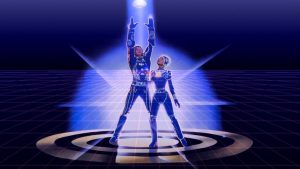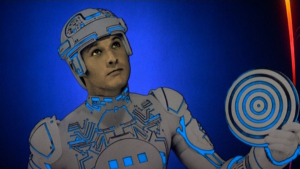Because of the recent news that the Tron franchise is apparently still a priority at Disney and plans for franchise-expanding sequels or reboots are still underway, I thought it might be interesting to take a circuitous stroll back down memory lane and revisit one of the strangest movies from what is often considered Disney’s Dark Age, in the early 1980’s. This era of the studio’s long and storied history isn’t known for producing a whole bunch of timeless classics (if there are any hardcore fans of The Black Cauldron out there, I’d love to know about them), nor box-office hits – but how do you even begin to describe Tron? The needlessly convoluted sci-fi adventure flick about glow-in-the-dark humanoid computer programs fighting to overthrow their tyrannical leadership doesn’t seem to fit neatly into any box, and so of course it has acquired a kind of well-earned cult classic status over the years – even leading to the creation of a poorly-received sequel in 2010 which, while not a box-office flop, failed to recapture much of what made the original film so…bizarrely endearing.

There are so many things wrong with Tron from a storytelling standpoint, and yet, despite quickly falling into the classic sci-fi/fantasy trap of trying to seduce the audience with incredibly complex world building instead of, you know, a particularly good story, or well developed characters (though, considering how badly the sequel’s attempts at character development went over, perhaps we weren’t missing anything anyway?), somehow it still works – or at the very least, it works about as well as a movie about warring sentient computer programs possibly could in 1982, at the very dawn of the age of special effects. Knowing some of the story about the cutting edge technology used to create the sprawling electronic landscape of The Grid (which, to the modern viewer’s eye, probably just resembles partly-completed digital artwork of Flatland) definitely helps to make the movie interesting from a cinephile’s point of view: its influence on CGI is far less well known than the influence of, say, The Little Mermaid on animation, but the two films are arguably comparable in terms of the lasting impact they made on the industry. The difference is that The Little Mermaid was a juggernaut that almost immediately birthed an unstoppable Disney renaissance – Tron was a financial disaster for the company that was snubbed at the Oscars for the Special Effects award it clearly deserved, apparently because Academy voters thought using computers was cheating.
That doesn’t make the work that went into designing Tron any less commendable, however. The film was born out of an idea to create a neon gladiator mascot for the fledgling Lisberger Studios, which felt that the character needed a starring vehicle to sell him to audiences and establish the studio’s brand – ironically, the cost of making the film became so high that Lisberger Studios had to turn to Disney for help with financing and marketing. In a classic case of studios being afraid to invest too heavily in something radically new, Disney allowed them to make the movie but decided not to give it the marketing push it also needed until too late in the game. Behind the scenes, the process of designing the world of Tron using rotoscoping and the even more grueling technique of backlit animation (which gives the movie its one-of-a-kind glow in the dark look) had to be fast-tracked to meet its release date, with director Steven Lisberger eventually having to hire a whole separate team of animators from Taiwan to ease the stress on his own employees. Miraculously, they managed to get the job done within nine months, a true credit to the power of teamwork.

But on its own, separated from its later impact and the behind-the-scenes work that went into it, just looking at the finished film as a whole: does it hold up? That’s a bit of a harder question to answer. As I said, Tron has a lot of story issues – the audience gets handed a whole bunch of information about the cyber world right up front, and is then expected to retain all that information for the next thirty minutes, while we watch the Real World storyline play out (which itself is pretty complicated). Then the Real World completely ceases to exist as far as the movie is concerned, and we’re plunged into The Grid, where computers wage brutal warfare against each other: highly ritualistic warfare involving motor-bike/smart car hybrids, but warfare nonetheless. There are solar sailers to be flown, beacons to be lit, and electric blue water to drink (I bring that up because there’s one scene of the main characters drinking said water that seems to go on for way longer than it probably needs to). It’s all very confusing.
Jeff Bridges and Bruce Boxleitner lead the cast of mostly identical white men trapped in glowing outfits with ridiculously oversized helmets, most of whom wield Frisbees to complete the look (a look which somehow warranted an Academy Award nomination for Best Costume Design). Bridges’ character, brilliant programmer and arcade video game champion Kevin Flynn, is supposedly the star of the movie, though there’s no good reason for why that is when Boxleitner’s character (dissatisfied ENCOM employee Allan Ward in the real world, legendary hero Tron on The Grid) has his name in the title, has just as much if not more plot agency than Bridges’, and actually is the clear male lead for the first thirty minutes of the movie. It’s like if Star Wars: A New Hope started out being about Luke Skywalker and then changed to become Han Solo’s story partway through (interestingly, there’s actually several similarities between Kevin Flynn and Han Solo, particularly in the sequel). David Warner gives the best performance in the film as the sinister E. Dillinger, President of the ENCOM company (in his Grid form as Sark, he comes off as a sad Darth Vader ripoff). As a side note: whenever Warner’s Dillinger was onscreen, I was constantly distracted by the nagging thought that, if Disney ever reboots this franchise, they absolutely need Ben Mendelsohn for this villainous role. Lora Baines (Cindy Morgan), the female lead, shows a lot of potential as a spunky scientist, but of course this is the 80’s, so it’s not long before she trades in her intelligent and pro-active role for the part of demure, soft-spoken damsel Yori. In keeping with the Hollywood tradition of rebooting classic franchises with the original male leads but conveniently forgetting to bring back the female leads, both versions of Morgan’s character were dropped for the sequel, despite her repeated efforts to try and contact Disney.
On the flip-side, two women played an integral role in giving Tron the eerie techno vibe we know and love: composer Wendy Carlos, an openly trans woman best known for her work on A Clockwork Orange and The Shining, collaborated with Annemarie Franklin on the score – parts of which, unfortunately, were removed by Disney and replaced with songs by Journey: the rock band’s contributions to the film were honored in the sequel via a slightly random use of the song “Separate Ways”. But Carlos’ iconic score is still a lasting testament, like all her work, to the often underappreciated achievements of trans people in the film industry.

I, for one, am glad that Tron will be getting another chance at proving its value to modern audiences: moviegoers (or, quite possibly, Disney+ subscribers) deserve a chance to see more stories from The Grid, told with the best new technology available to the studio, and longtime fans of the franchise deserve a continuation of a series that has been pretty much dead for a long time. We all deserve a little more Tron in our lives.
End of line.
Movie Rating: 7.8/10